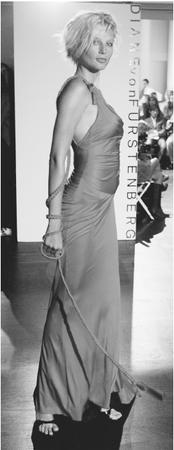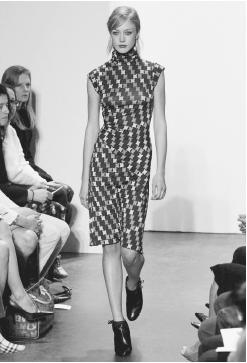Diane Von Furstenberg - Fashion Designer Encyclopedia
Belgian designer working in New York
Born: Diane Michelle Halfin in Brussels, Belgium, 31 December 1946; immigrated to the U.S., 1969. Education: Studied at the University of Madrid, graduated in economics, University of Geneva. Family: Married Prince Egon Von Furstenberg, 1969 (divorced, 1983); married USA Network Chairman Barry Diller, 2001; children: Alexandre, Tatiana. Career: Owner/designer, Diane Von Furstenberg Studio, 1970-77, and from 1985; established couture house, 1984-88; produced signature cosmetics line, 1977-83; introduced Tatiana fragrance, 1977; began marketing products on QVC, 1990s; named planning director, Q2, 1994; relaunched business, 1997; published autobiography, 1998; opened in-store boutiques at Henri Bendel, 2001. Awards: Fragrance Foundation award, 1977; City of Hope Spirit of Life award, Los Angeles, 1983; Savvy Magazine award, New York, 1984, 1985, 1986, 1987, 1988; Einstein College of Medicine Spirit of Achievement award, New York, 1984; Mayor of the City of New York's Statue of Liberty medal, 1986. Address: 385 West 12th Street, New York, NY, U.S.A.
Publications
By VON FURSTENBERG:
Books
Diane Von Furstenberg's Book of Beauty, New York, 1976.
Beds, New York, 1991.
Diane: A Signature Life, with Linda Bird Francke, New York, 1998.
On VON FURSTENBERG:
Books
Reeves, Richard, Convention, New York, 1977.
Morris, Bernadine, and Barbara Walz, The Fashion Makers, New York, 1978.
Milbank, Caroline Rennolds, New York Fashion: The Evolution of American Style, New York, 1989.


Stegemeyer, Anne, Who's Who in Fashion, Third Edition, New York, 1996.
[profile] in Almanac of Famous People, Sixth Edition, Detroit, 1998.
[profile] in Encyclopedia of World Biography, Second Edition, Detroit, 1998.
contributor, to Bonnie Miller Rubin, Fifty on Fifty: Wisdom, Inspiration, and Reflection on Women's Lives Well Lived, New York, 1998.
Articles
Rothmyer, Karen, "Once Upon a Time a Princess Made It with the Hoi Polloi," in the Wall Street Journal 17 January 1976.
Francke, Linda Bird et al, "Princess of Fashion," in Newsweek 28 March 1976.
Rowes, Barbara, "Women Buy, But Men Dominate…Then Came DVF," in People, 14 May 1979.
Wallach, Leah, "What Makes Diane Run?" in Metropolitan Home (New York), September 1982.
Blandford, Linda, "I Was Very Very Clever and Very Very Devious," in The Guardian, 9 March 1983.
Scholl, Jaye, and Paula Span, "The Savvy 60: The Top U.S. Businesses Run by Women," in Savvy (New York), February 1984.
Alai, Susan, "Fashion's Shy Di: DVF through the Ages," in W, October 1985.
Szabo, Julia, "Diane Von Furstenberg," in Vogue, January 1991.
Dyett, Linda, "Women of Style: Princess Di and Her Daughter," in Lears, June 1991.
Podolsky, J.D., "Not Lying on Her Laurels," in People, 7 December 1991.
Givhan, Robin D., "Cut-Rate Princess; Designer Diane Von Furstenburg Caters to the Masses—and Their Money," in the Washington Post, 5 January 1996.
White, Constance C.R., "Von Furstenberg's Return," in the New York Times, 22 April 1997.
Spindler, Amy M., "Breaking the Rules, Again," in the New York Times, 16 September 1997.
"In Style," in Paris Match, May 1998.
Barron, James, "Accidental Tourist," in the New York Times, 1 September 1998.
Chin, Paula, "Diane: A Signature Life by Diane Von Furstenberg," in People, 9 November 1998.
"DVF's Open House," in WWD, 27 April 2000.
Ferla, Ruth, "For Diller and Von Furstenberg, a Merger," in the New York Times, 3 February 2001.
"It's a Wrap," in Harper's Bazaar, March 2001.
Foley, Bridget, "DVF's New Life," in W, April 2001.
McCants, Leonard, "DVF Set to Open First Store," in WWD, 18 April 2001.
Czarra, Kerstin, and Anna Rachmansky, "Ladies Night; Two Powerful Forces of American Style…," in Footwear News, 30 April 2001.
McCants, Leonard, "DVF's New Uptown Outpost," in WWD, 29 May 2001.
Horyn, Cathy, "Mysteries of Inspiration: Spring 2002 in the Making," in the New York Times, 4 September 2001.
Menkes, Suzy, "Theater, Von Furstenberg-Style," in the International Herald Tribune, 11 September 2001.
"Diane Von Furstenberg: Runway Fashion Photos," available online at Fashion Showroom, www.fashionshowroom.com , 16 October 2001.
"Diane Von Furstenberg: The Queen of the Wrap," online at from Lifetime TV, www.lifetimetv.com , 16 October 2001.
"Diane Von Furstenberg," available online at Vintage Vixen, www.vintagevixen.com , 16 October 2001.
*
I got into fashion almost by accident, inspired to create the pieces I wanted, but couldn't find, in my own wardrobe. From my original 1970s' knit wrap dress, to my new 1990s' stretch "sock dress," I believe in marrying fashion and function—chic style and easy comfort, maximum impact and minimum fuss. Today I look to the modern woman; pulled in many different directions in the course of a day, she juggles multiple roles depending on the situation, but always knows who she is and what's really important in her life.
I like to say that "I design a line the way I pack a suitcase," visualizing all of the different places I'm going to be, and then creating the appropriate outfits. My clothing must be timeless and versatile, so that a few simple pieces add up to many different looks. I think building a wardrobe should be like compiling a scrapbook of your life—over the years you accumulate favorite pieces, like old friends, that you always come back to for their unfailing ability to make you feel safe or confident, sexy or secure, depending on what you need.
Fabrics are key, since they're like a second skin, and should always be soft to the touch and breathable. Colors should be beautiful and harmonious, and silhouettes simple, allowing the body to move freely. All in all, clothes should complement a woman, the perfect accessories to her beauty and lifestyle.
—Diane Von Furstenburg
***
When Diane Von Furstenburg married Prince Egon Von Furstenburg in 1969, she became a princess—this aristocratic title proved no mean asset when she embarked on a fashion career in 1969, after moving from Europe with her husband to the United States. The cachet of "Princess" on a label proved especially potent to American buyers, aware of the American public's fascination with titles.
Putting the preeminence of rank aside, Von Furstenburg began her career with no fashion training. Her qualifications were a degree in economics from the University of Geneva and fluency in five languages. She did, however, have knowledge of international high society and culture. For a short period after her marriage, both she and her husband were celebrities among the party-going jet set of the late 1960s, and for a time there was not a party that they did not attend. Von Furstenburg started her business during this period with a range of simple dresses she had produced in Italy. They were a reaction to the jeans dressing so prevalent at the time, providing an easy, elegant alternative for women who wanted to wear a dress. Selling the clothes herself by tugging a sample rail around various American stores, she became an immediate success and a known designer name almost overnight.
Her philosophy was simple—to create elegant ease for all women. "There was a need for my things, for very simple dresses everyone could wear," she said in an interview for the book The Fashion Makers (New York, 1978). Both slim and large women could wear the clothes, senator's wives or secretaries. They were sexy and chic regardless of the customer because they were designed to be sexy, accessible, and easy to wear. Von Furstenburg's business quickly flourished and expanded. Highly successful lines of cosmetics, scent, handbags, shoes, jewelry, table linens, furs, stationery, wallpaper, and designs for Vogue Patterns were produced. She even published a Book of Beauty in 1976 detailing many of her philosophies toward life and design. She established herself as a liberated role model for many women. When she declared, "You don't sit around in little white gloves and big hats and try to look fashionable. You have a job, a husband or lover and children," she was stressing the practicality with style needed to adapt to modern life, which in many ways sums up her design philosophy.
Von Furstenburg resumed her business in the 1990s selling via television. Her contribution to fashion rests on a universal practicality; she believes in the importance of finding a style right for the individual, which is why many of her collections have featured very simple, flattering clothes. They can be dressed up or down and versatile enough for all sorts of women to feel attractive in. "Stick with them," she advises her customers when they have found Diane Von Furstenburg clothes to suit them.
When Von Furstenberg succeeded on QVC, the home-shopping network, she and daughter-in-law Alexandra relaunched her business in 1997 at a freestanding boutique/studio/residence in West Village, New York. The store revitalized her standby, the slinky knit wrap dress, and ventured into new territory with sportswear and intimate apparel. In 1998 Von Furstenberg, with the help of Linda Bird Francke, published an autobiography, Diane: A Signature Life, which New York Times book critic Michele Orecklin described as "breezy reading for anyone who enjoys columns with a plenitude of boldfaced names," including Henry Kissinger and Jerry Brown, former governor of California. Feminist icon Gloria Steinem saluted the work as a record of Von Furstenberg's "professional struggles as well as her private ones to raise children and stay a whole person."
In late April 2001, Von Furstenburg began merchandising her expanded line in a 600-square-foot shop-within-a-shop upstairs at Henri Bendel on Fifth Avenue in Manhattan. Under one roof, she coordinated designs, showing, and sales. Amid the signature DVF inlaid frosted mirrors, black slate floors, and see-through lightboxes, her staff attempted to match fashions to womanly, self-confident customers. Supported by vintage 1972 advertising on a billboard in the meat-packing district opposite the restaurant Pastis, the new store promoted the designer's mantra: "Feel like a woman, wear a dress."
Directing retail at the Hudson River location was Nicole Martaheleur, formerly a jewelry merchandiser for Agatha. Of the store's unified effort, Von Furstenberg told Women's Wear Daily, "I needed to do a store to have a full showcase. This is the one place in the world where you can see the full selection." She promised a steady flow of surprises, including plans for a Paris outlet.
—Kevin Almond;
updated by Mary Ellen Snodgrass
Comment about this article, ask questions, or add new information about this topic: